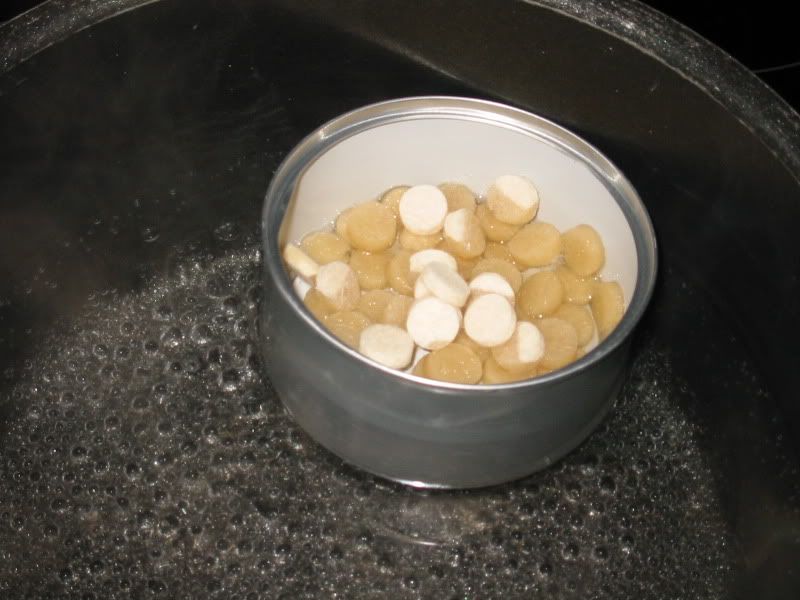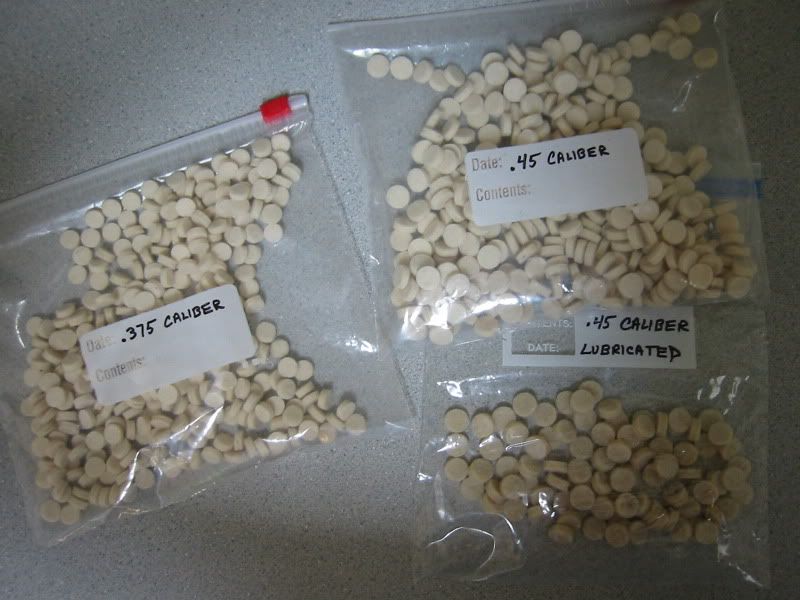Yes, this is yet another thread about making wads for your cap-n-ball BP revolver. Lubricated felt wads can be used in the loading process to provide several advantages over plain cap-powder-ball loading. Specifically, among these advantages are:
1. Added sealing of the chamber to further reduce risk of chain fire.
2. Lubrication to aid in softening of powder residue/fouling.
3. Less messy as compare to grease/crisco/oil on top of the ball.
4. Scrubbing/cleansing effect as the hard felt wad travels down the barrel.
There are those who may frown upon the use of lubricated felt wads preferring to either load plain cap-powder-ball or to smear grease over the ball. We do know that highly respected sources have recommended the use of a lubricated felt wad since at least 1930. Something tells me the smart fella who gave that advice probably learned that from some old timer's who learned it well before the 1930's.
The purpose of this thread is to provide some information to those too cheap, like myself, to buy pre-made lubricated wads and who prefer a more economical solution.
What you will need:
1. Felt
A perfect inexpensive source for the type of felt you want to use can be found at Duro-Felt. You want to use a product that is 100% wool and is hard/dense felt such as the FM1812H product. I placed an order with Duro-Felt online and received it in my mailbox two days later (Arkansas to Florida). That 12" x 36" piece for $12 is enough to punch out over 1500 wads of .44/.45 caliber or over 2100 wads of .36/.380 caliber. I passed on the local Goodwill store as a source for cheap felt. I didn't want to deal with guessing the hardness or thickness of old used wool hats or trenchcoats or any critters that may or may not reside in said source of felt.
2. Punches
For punches a great solution are the hollow punch set found at Harbor Freight. Typically only $5.99 but often cheaper on sale at $4.99 or with the use of a coupon.
3. Lubricant
For lubricant there are going to be many varying opinions on what to use. For the purpose of keeping it simple here I'm going to specify the use of real beeswax mixed with Crisco shortening. Generally a 50-50 mix but vary it to suit your needs or temperature requirements. Also, you may consider using Bore Butter as your lubricant as it would appear that lubricated Wonder Wads use just plain ol' BB. There are many sources for beeswax online. Generally, the beeswax prices are reasonable but when you add shipping costs it can double the overall price. One readily available local source, for many, is Michael's Crafts. They generally charge around $18 for a pound of pure beeswax but be smart and use a 40% or 50% coupon to get the cost down to reasonable levels.
Below is a pic of the HF punch set. It comes with 9 hollow punches. For my purposes only two of the punches are of interest. Specifically, the 3/8" (0.375") and the 7/16" (0.4375") punches. The 3/8" punch serves the .36 caliber revolvers and the 7/16" serves the .44/.45 caliber revolvers. Some of you will be able to make good use of the 1/2" (0.500") punch.
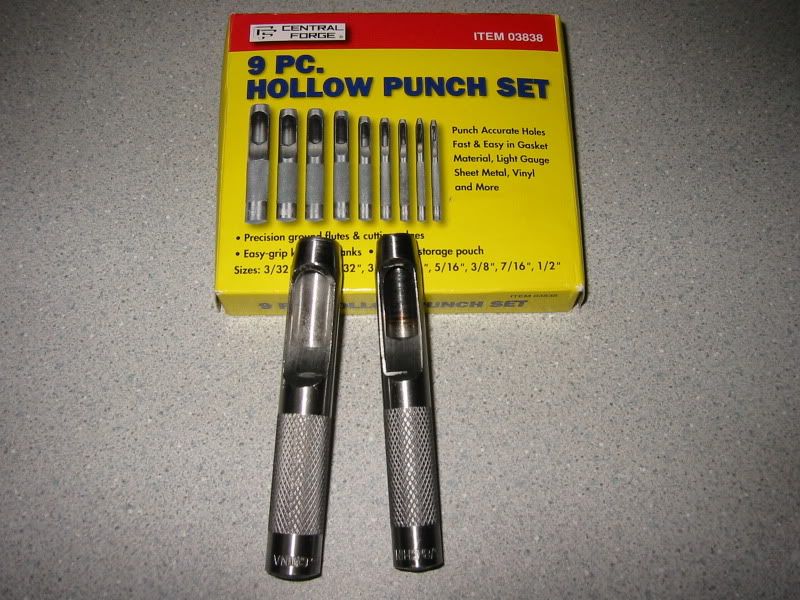
The 0.4375" diameter of the 7/16" punch isn't quite large enough to satisfy my need for a .45 caliber wad. So, using my trusty grinder bit that fits my Dremel tool I decided to open up the diameter to something more suitable for .45 caliber revolvers.
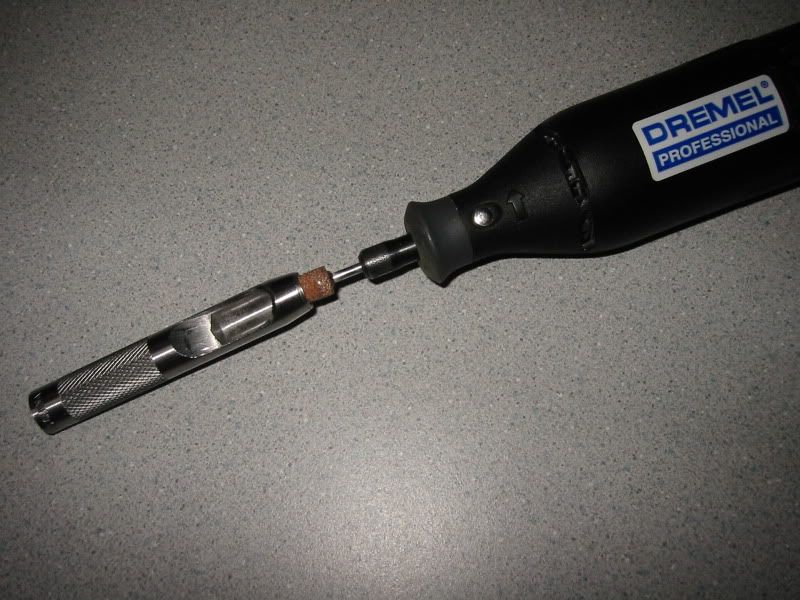
I increased the diameter of the 7/16" punch to 0.455". It only took a couple of minutes to do this with the Dremel tool. While I was at it I decided to increase the diameter of the 3/8" punch from 0.375" to 0.380". Just enough to make the cutting edge really sharp.
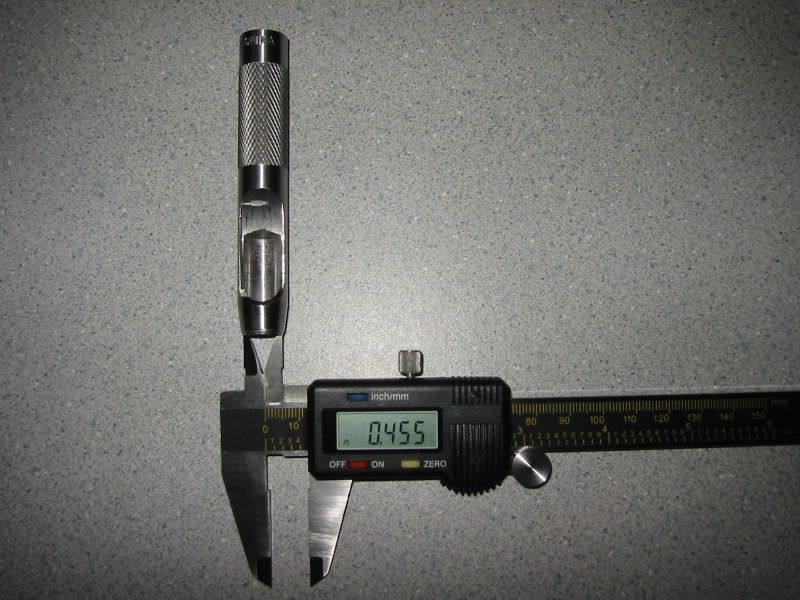
Next, it was just a matter of sitting in front of the TV with mindless TV on and punching out the wads. I used an old chunk of a cedar tree to punch on top of. The punches, after increasing their diameters, are so sharp it doesn't take much effort to punch out the hard felt. In a matter of a 20 minutes I was able to punch out hundreds of wads. You can use a chunk of 4x4 or 2x6 as your cutting surface to punch on top of.
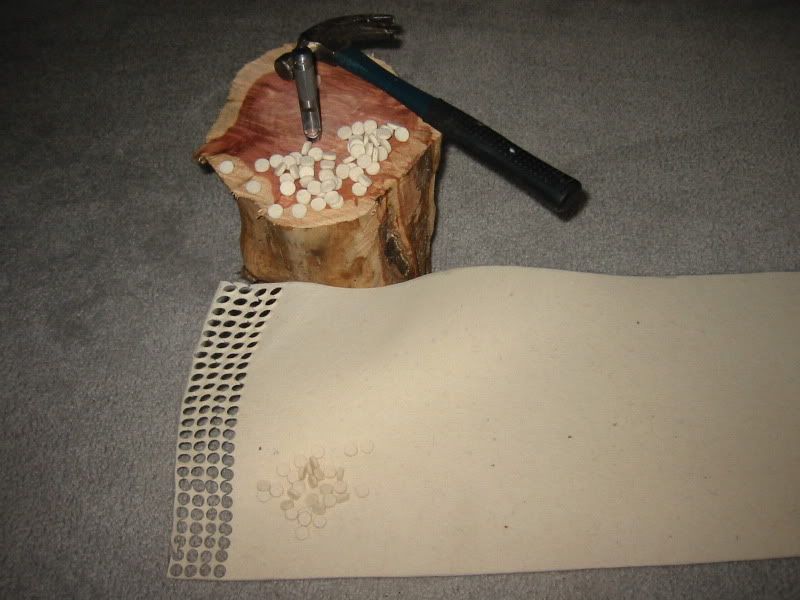
The last step is to lubricate your felt wads with your choice of lubricant. The easy way may be to use Bore Butter like the Wonder Wad brand uses. My concoction is a mix of beeswax and Crisco as explained above. Our expert member, Gatofeo, has an old time recipe he has shared time and time again which is apparently one that is hard to beat in terms of performance.
With the lubricant in a melted liquid form it is just a matter of dipping/soaking the un-lubricated felt wads in the solution sufficiently. Remove the soaked felt wad while the lubricant is still dripping hot and let cool. Some of you have complained that you didn't think that lubricated Wonder Wads had enough lubricant on them. Here is your chance to make some wads that are really loaded up with lubricant.
If anyone has cheaper or better sources for materials please chime in. This post isn't meant to be a "this way or the highway" type post. Rather, it is one cheapskate's method to make lubricated felt wads by giving actual sources/links for materials.
1. Added sealing of the chamber to further reduce risk of chain fire.
2. Lubrication to aid in softening of powder residue/fouling.
3. Less messy as compare to grease/crisco/oil on top of the ball.
4. Scrubbing/cleansing effect as the hard felt wad travels down the barrel.
There are those who may frown upon the use of lubricated felt wads preferring to either load plain cap-powder-ball or to smear grease over the ball. We do know that highly respected sources have recommended the use of a lubricated felt wad since at least 1930. Something tells me the smart fella who gave that advice probably learned that from some old timer's who learned it well before the 1930's.
The purpose of this thread is to provide some information to those too cheap, like myself, to buy pre-made lubricated wads and who prefer a more economical solution.
What you will need:
1. Felt
A perfect inexpensive source for the type of felt you want to use can be found at Duro-Felt. You want to use a product that is 100% wool and is hard/dense felt such as the FM1812H product. I placed an order with Duro-Felt online and received it in my mailbox two days later (Arkansas to Florida). That 12" x 36" piece for $12 is enough to punch out over 1500 wads of .44/.45 caliber or over 2100 wads of .36/.380 caliber. I passed on the local Goodwill store as a source for cheap felt. I didn't want to deal with guessing the hardness or thickness of old used wool hats or trenchcoats or any critters that may or may not reside in said source of felt.
2. Punches
For punches a great solution are the hollow punch set found at Harbor Freight. Typically only $5.99 but often cheaper on sale at $4.99 or with the use of a coupon.
3. Lubricant
For lubricant there are going to be many varying opinions on what to use. For the purpose of keeping it simple here I'm going to specify the use of real beeswax mixed with Crisco shortening. Generally a 50-50 mix but vary it to suit your needs or temperature requirements. Also, you may consider using Bore Butter as your lubricant as it would appear that lubricated Wonder Wads use just plain ol' BB. There are many sources for beeswax online. Generally, the beeswax prices are reasonable but when you add shipping costs it can double the overall price. One readily available local source, for many, is Michael's Crafts. They generally charge around $18 for a pound of pure beeswax but be smart and use a 40% or 50% coupon to get the cost down to reasonable levels.
Below is a pic of the HF punch set. It comes with 9 hollow punches. For my purposes only two of the punches are of interest. Specifically, the 3/8" (0.375") and the 7/16" (0.4375") punches. The 3/8" punch serves the .36 caliber revolvers and the 7/16" serves the .44/.45 caliber revolvers. Some of you will be able to make good use of the 1/2" (0.500") punch.

The 0.4375" diameter of the 7/16" punch isn't quite large enough to satisfy my need for a .45 caliber wad. So, using my trusty grinder bit that fits my Dremel tool I decided to open up the diameter to something more suitable for .45 caliber revolvers.

I increased the diameter of the 7/16" punch to 0.455". It only took a couple of minutes to do this with the Dremel tool. While I was at it I decided to increase the diameter of the 3/8" punch from 0.375" to 0.380". Just enough to make the cutting edge really sharp.

Next, it was just a matter of sitting in front of the TV with mindless TV on and punching out the wads. I used an old chunk of a cedar tree to punch on top of. The punches, after increasing their diameters, are so sharp it doesn't take much effort to punch out the hard felt. In a matter of a 20 minutes I was able to punch out hundreds of wads. You can use a chunk of 4x4 or 2x6 as your cutting surface to punch on top of.

The last step is to lubricate your felt wads with your choice of lubricant. The easy way may be to use Bore Butter like the Wonder Wad brand uses. My concoction is a mix of beeswax and Crisco as explained above. Our expert member, Gatofeo, has an old time recipe he has shared time and time again which is apparently one that is hard to beat in terms of performance.
With the lubricant in a melted liquid form it is just a matter of dipping/soaking the un-lubricated felt wads in the solution sufficiently. Remove the soaked felt wad while the lubricant is still dripping hot and let cool. Some of you have complained that you didn't think that lubricated Wonder Wads had enough lubricant on them. Here is your chance to make some wads that are really loaded up with lubricant.
If anyone has cheaper or better sources for materials please chime in. This post isn't meant to be a "this way or the highway" type post. Rather, it is one cheapskate's method to make lubricated felt wads by giving actual sources/links for materials.
Last edited:

